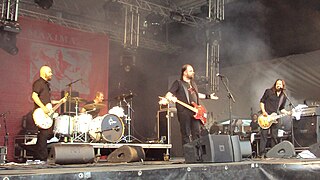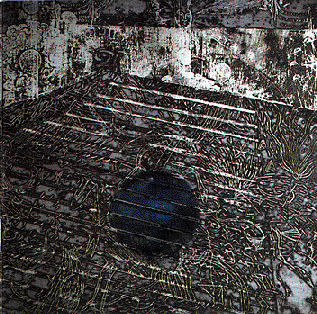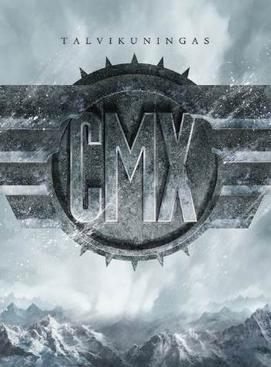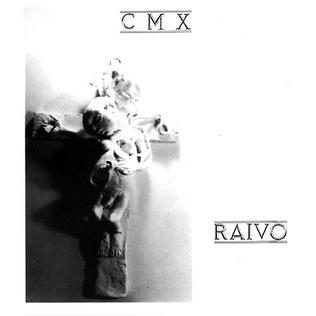
CMX, originally Cloaca Maxima, is a Finnish rock band. They originally played hardcore punk, but soon expanded to play a wide variety of rock formats, including progressive rock, heavy metal, and mainstream rock 'n' roll. Throughout their career, they have been influenced by progressive rock bands such as Rush, Yes, Tool and King Crimson. The progressive influence is most evident on their albums Dinosaurus Stereophonicus (2000) and Talvikuningas (2007).

Dinosaurus Stereophonicus is the eighth album by the Finnish rock group CMX, released in 2000. It was recorded after the band had decided to stop touring and become a full-time studio band. The decision only lasted until 2002.

Aion (2003) is an album by the Finnish rock group CMX. The word Aion is Ancient Greek for "age, life-force" and also a Finnish verb form meaning "I intend ".

Aurinko (1992) is an album by the Finnish rock group CMX. The word "Aurinko" means "The Sun" in Finnish. The album cover depicts a cross section of a pineapple.

Aura (1994) is an album by the Finnish rock group CMX. The album gained the band its first near-hit single and some commercial airplay with "Ruoste". Although many people consider Aura to be the band's seminal record, at this point many older fans were already scoffing at the more streamlined, acoustic songs and mellow soundscapes as compared to their earlier hardcore steamrolling. However, Aura pretty much defines the band's sound up to this day, with a mixture of heavy and light elements and songwriting reminiscent of 1960s and 1970s progressive rock.

Kolmikärki (Trident) is CMX's 1990 debut album. Despite CMX's roots in punk, the musical style of the album varies greatly. The record meshes hardcore, heavy metal, acid rock, some jazz, ballads and waltz. A. W. Yrjänä's lyrics on the album contain a lot of religious imagery for which the band is still known. The lyrics have been influenced by a variety of religions, including Buddhism and Christianity, as well as drawing influence from shamanism. CMX's music has changed significantly since this early album, but their enthusiasm for experimenting with different musical styles has lived on.

Rautakantele is a 1995 album by the Finnish rock group CMX. "Rautakantele" is Finnish and means "The Iron Kantele".

Cloaca Maxima (1997) is the first compilation album by the Finnish rock group CMX. The name Cloaca Maxima means "Great Sewer" in Latin, and was also an early name of the band before it was shortened to CMX. The compilation contains three CDs named Physis, Aetheris and Astralis respectively. Physis, contains rock songs from their albums and EPs, while Aetheris focuses on softer material. The third CD is reserved for B-sides of singles and some new songs recorded solely for the compilation.

Cloaca Maxima II (2004) is the second compilation album by the Finnish rock group CMX, released seven years after their first compilation Cloaca Maxima. The name Cloaca Maxima means "Great Sewer" in Latin, and was also the name of the band before it was shortened to CMX. The compilation consists of three CDs named Lyijy, Helium and Uraani respectively. The names of the CDs are all names of chemical elements in Finnish: Lead, Helium and Uranium. The compilation is divided between CDs in a similar way to the earlier Cloaca Maxima. Lyijy contains rock songs that CMX would usually play on stage, while Helium focuses on softer material. Uraani is reserved for B-sides of singles and some other CMX rarities. Three new songs were recorded exclusively for the compilation.

Vainajala (1998) is an album by the Finnish rock group CMX. Vainaja is Finnish for a dead person, Vainajala meaning a name of a place inhabited by the dead.

Discopolis is the sixth studio album by the Finnish rock group CMX.

Isohaara is the ninth studio album by the Finnish rock group CMX. The album is named after Isohaara power plant in Keminmaa. The band spent six months in the studio because of the chosen songwriting method: the songs were written and rehearsed at the studio under constant perfecting and re-arranging. Musically the album is lighter and more accessible than its predecessor, the over 100-minute Prog-epoch Dinosaurus Stereophonicus.

Veljeskunta (1991) is an album by Finnish rock band CMX. Its name means "The Brotherhood" in Finnish.

Talvikuningas (2007) is an album by the Finnish rock group CMX. The title is Finnish and translates to "The Winter King".
"Kultanaamio" is the second single from the Finnish rock band CMX's 1994 album Aura. It also appears on the group's first compilation album Cloaca Maxima. "Kultanaamio" means "Golden Mask" in Finnish.

"Pelasta maailma" is the first single from the CMX album Rautakantele. It also appears on the compilation album Cloaca Maxima. The chorus contains a quote from a poem by L. Onerva. "Pelasta maailma" means "Save the World" in Finnish.

Tanssitauti is an EP by CMX released in 1990. The band had released their debut album Kolmikärki earlier the same year with a different lineup. Tanssitauti is the first CMX recording to feature guitarist Janne Halmkrona, who appears on all of the band's albums from this point on.

Raivo is the second EP by Finnish rock band CMX. It is seen as their heaviest, most aggressive hardcore recording. One song, "Hiki", made it to their 1997 compilation album Cloaca Maxima. The Raivo EP, along with Johannes Kastaja, is included on the 2002 re-release Kolmikärki Gold.

Iäti is thirteenth album by the Finnish rock group CMX. It was released in 2010, three years after the previous Talvikuningas. Compared to the previous album Iäti is more of a traditional rock album. It ranked first as most sold album on The Official Finnish Charts.

Seitsentahokas is the fourteenth album by the Finnish rock group CMX. It was released in 2013 and ranked as most sold album on The Official Finnish Charts.



















